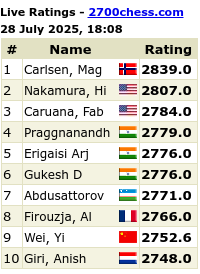For those that are not sure what this is, essentially the reloader tactic involves sacrificing a piece (e.g. Knight-1) which MUST be taken due to the threat it poses ... but once this threat has been expunged then the same threat can be recreated (reloaded) with another piece of the same type or movement (e.g Knight-2).
In this game I used Knight-1 to create the first threat (my opponent resigned here but if Knight-1 had been eliminated then I could then have reloaded the threat with Knight-2!).
As usual - any comments welcome!!
1. d4 Nf6 2. d5 c5 3. Nc3 d6 4. e4 e5 5. dxe6 Bxe6 6. Bd3 Be7 7. Nf3 O-O 8. O-O Nc6 9. Ng5 Bg4 10. Be2 Bxe2 11. Qxe2 Nd4 12. Qd2 Nd7 13. Nh3 Nb6 14. a4 Nc4 15. Qd3 Ne5 16. Qd2 Ndf3+ 1-0
PGN Viewer courtesy of http://chesstempo.com/












